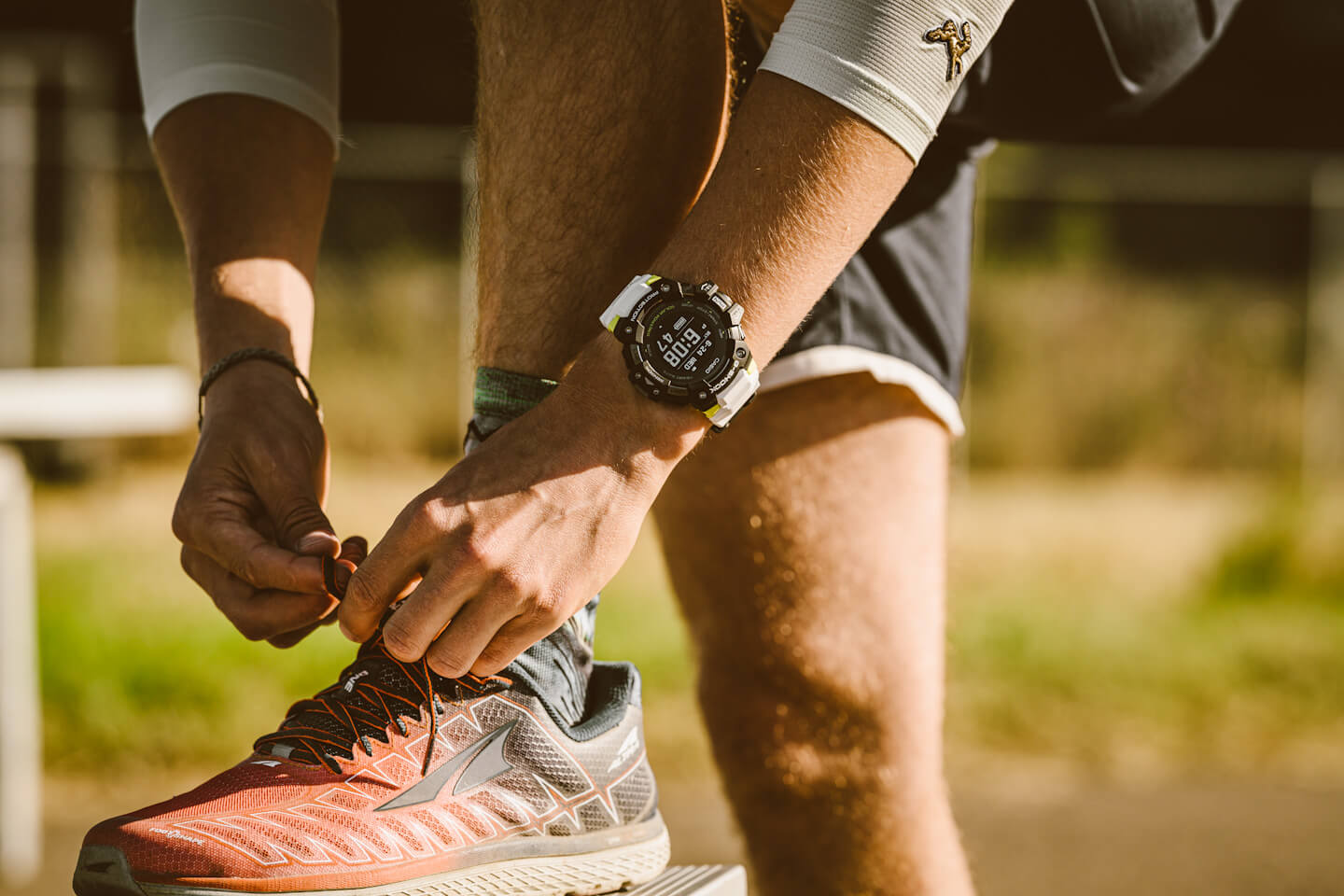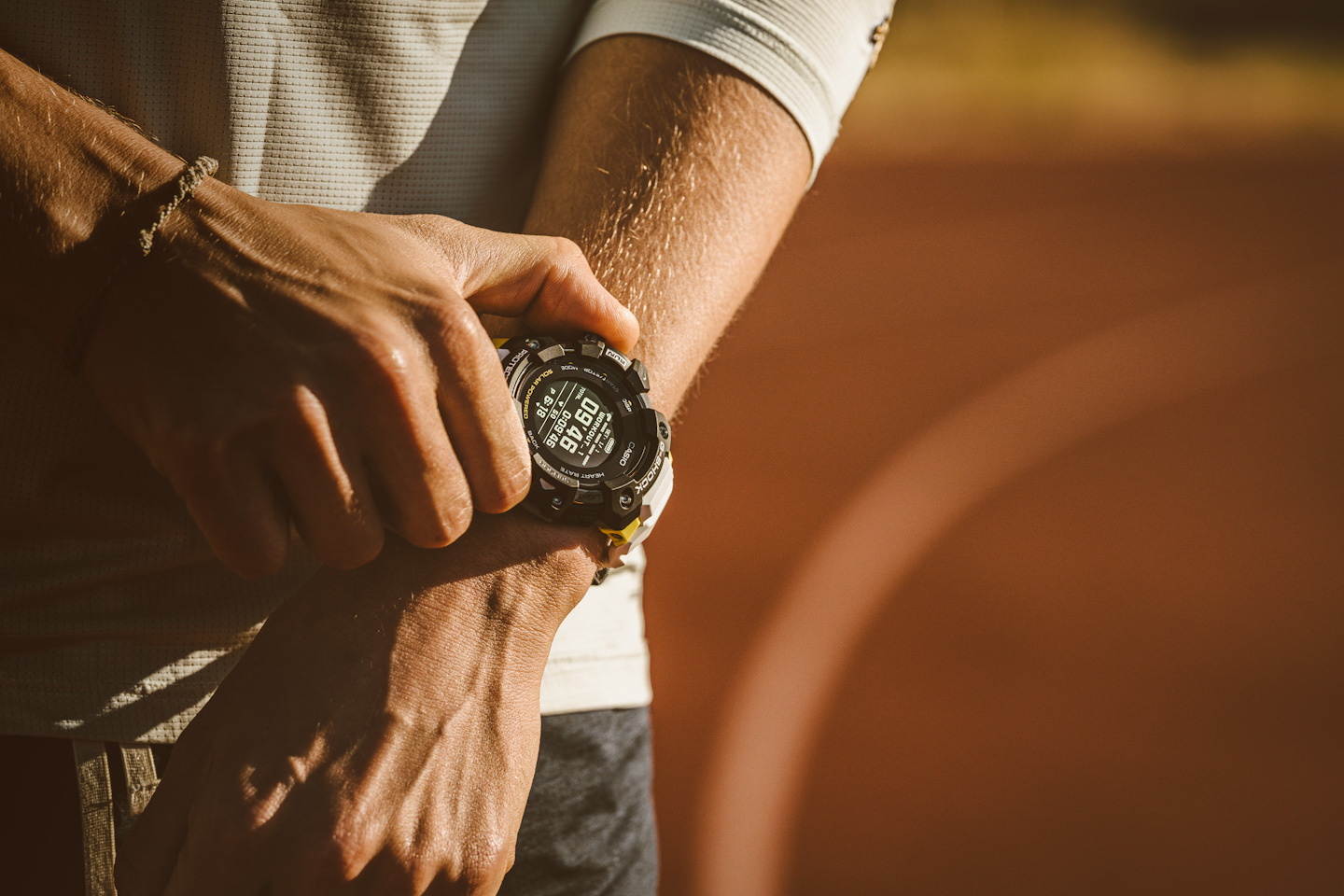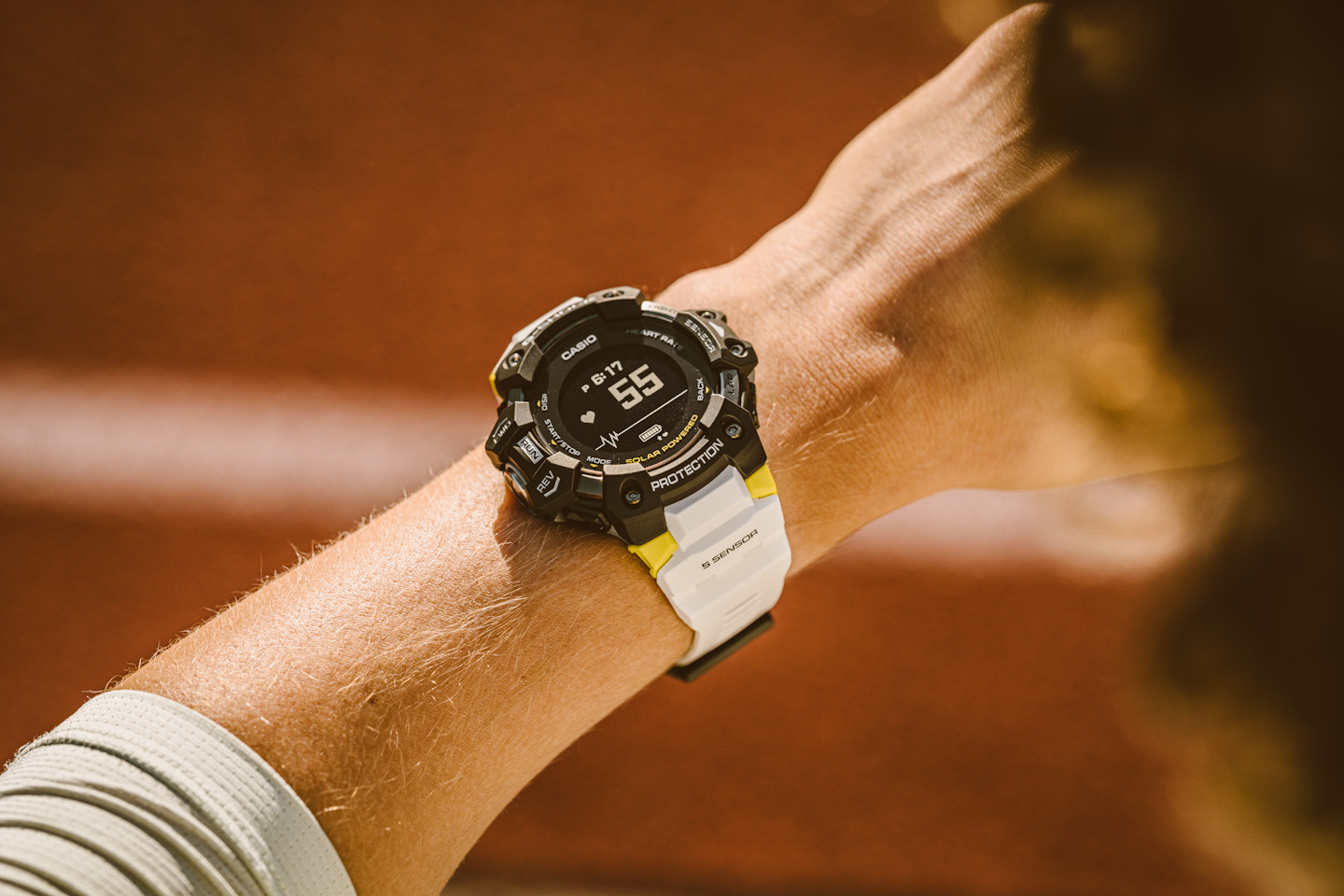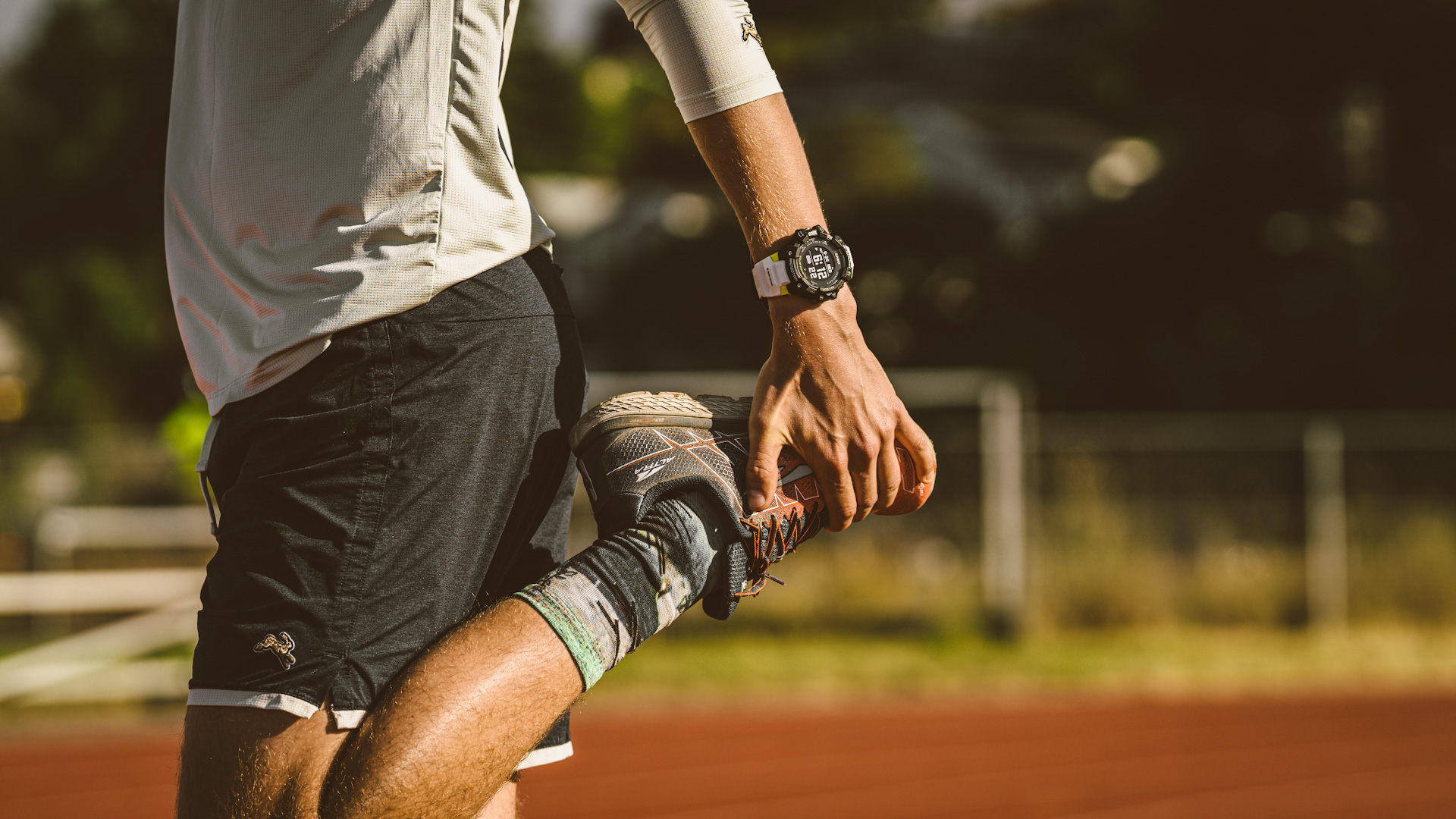 The Casio G-Shock Move GBDH1000 timepiece collection is the most advanced fitness and exercise tracking device ever produced by Japan’s Casio. With legendary G-Shock durability, the GBDH1000 collection combines GPS tracking, Bluetooth connectivity, and heart rate monitoring for a complete training and exercise-planning solution. Casio designed the G-Shock Move for advanced athletes, as well as novices who simply want to track their fitness activity while also enjoying the benefits of a daily-wear G-Shock wristwatch.
The Casio G-Shock Move GBDH1000 timepiece collection is the most advanced fitness and exercise tracking device ever produced by Japan’s Casio. With legendary G-Shock durability, the GBDH1000 collection combines GPS tracking, Bluetooth connectivity, and heart rate monitoring for a complete training and exercise-planning solution. Casio designed the G-Shock Move for advanced athletes, as well as novices who simply want to track their fitness activity while also enjoying the benefits of a daily-wear G-Shock wristwatch.
Here’s a quickstart guide to exercise tracking with the reference GBDH1000.

Setting Up The G-Shock Move Watch + Smartphone App
Casio’s engineers have always had a preference for simple, hassle-free experiences. You can wear and enjoy the G-Shock Move GBDH1000 right out of the box if you download its companion G-Shock Move application and configure your personal settings.
The G-Shock Move GBDH1000 includes on-board Bluetooth, which uses a dedicated G-Shock Move app to connect with the watch. The timepiece itself can store a series of recorded workout session data logs, and you can review your performance right on the watch, but additional information becomes available when you view your workout activity on the G-Shock Move app. The G-Shock Move app also offers ways to configure your workout preferences and goals that expand upon the watch’s core functionality.
Using low-power Bluetooth, the GBDH1000 connects to a paired smartphone and also allows incoming notifications on the easy-to-read MIP LCD screen. The G-Shock Move screen is extremely legible in even bright light and merely sips energy when compared to traditionally back-lit smartwatch screens. It is important to ensure the app has recently synchronized with the G-Shock Move watch so that you view your latest activity data there, while also adjusting various features of the watch when desired.
Unlike previous generation G-Shock watches, even those with Bluetooth connectivity, the G-Shock GBDH1000 has an interface whose design and data screens can be changed from within the app. Casio fans will find something new to learn with the fresh G-Shock operating system interface, but the learning curve will be well worth the added new features that are now available.
 Starting Your Workout & The Basic Data Screens
Starting Your Workout & The Basic Data Screens
The GBDH1000 watches are the first G-Shock products to sport the new “5 Sensor System.” Historically, the first three sensors have been an altimeter, barometer, and compass (as well as thermometer). Casio recently introduced a pedometer (step counter) as the “fourth” sensor. The fifth sensor is a heart rate monitor, and it is one of the most useful features of the GBDH1000 — and the first time a heart rate sensor has been available in a G-Shock watch.
You can view your heart rate (and heart rate trends) at any time, but tracking your heart rate is a crucial part of the core functionality of the G-Shock Move. More on that below. To get a workout tracking session started, the G-Shock Move merely requires the press of a dedicated button, aptly titled “Run.” Casio engineered the G-Shock move to be mostly relied upon by people who engage in running, hiking, and other foot-based activities (though the G-Shock Move GBDH1000 can also be used for cycling).
Once the G-Shock Move has begun tracking your current activity, it will immediately track data most useful to regular runners and hikers. That data includes the total duration of the workout (a series of lap times are also available), your geo-position using GPS tracking, your heart rate, the elevation gained or lost, your blood oxygenation (VO2 Max), your steps, and the distance you have traveled. Using this data and your personal information, the system also makes predictions about the number of calories burned during the workout.
Scrolling through the various screens is done by pressing the Menu button — behavior that G-Shock fans will be very familiar with. The GBDH1000 watch case itself uses five pushers to help input all the commands. Menu screens now have different display options, which are sub-menus that offer additional data or that display the data differently. For example, when viewing your current heart rate, you can also choose to display a screen with a graph showing your heart rate trends over the day.
Casio designed the G-Shock GBDH1000 to provide the user with a lot of data even when the watch is currently tracking a workout. All of the sensor data is available, such as being able to use the compass or altimeter while in tracking mode, as well as giving the user choices on how they may like the data displayed. This is important because it will not always be convenient to use your fingers when you’d rather see data at a glance via the default screen. The dial can be configured to currently display the current time, the total distance you’ve traveled, and your heart rate. A number of data display options are available and meant to minimize the time you need to spend fiddling with your watch while working out.
Speaking of working out, Casio developed a new “workout” mode for the GDBH1000 — a programmable series of countdown timers. This useful feature is perfect for interval training when you want your watch to alert you (via sound and vibration) at the end of each interval. Intervals can further be programmed to repeat up to 20 times. More so, a total of five workouts, each with up to 20 repeatable intervals that can run in succession.
Using Lap Timers & Getting The Most Out Sensor Data While Exercising
Athletes and other people who like to evaluate their own performance frequently engage in lap timing in the midst of a workout session. The G-Shock GBDH1000 also makes a record of other available sensor data for laps taken within a longer activity session. The performance results of these can be viewed independently from the total activity period from within the logs or via the G-Shock Move app. Lap timing is as easy as the press of one button in the G-Shock Move, but other useful pieces of data available include the total time of an activity, the distance traveled, and your current heart rate.
In many instances, the true measure of one’s workout performance is the measure of distance traveled. GPS functionality in the G-Shock GBDH1000 allows it to precisely track how far (and how high) a wearer has gone. This information, when combined with the total time of your session, is where you’ll be trying to push yourself the most if your goal is to improve when running, jogging, or hiking in similar places on repeat occasions.
Heart rate and the related VO2 Max measures are also important and useful information to track while working out. In general, simply measuring your heart rate during normal parts of the day when wanting to monitor your stress and anxiety levels. While working out, you don’t merely want to increase your heart rate, but rather you want your heart rate to fluctuate through a period of lower and higher intensity. Using a heart rate monitor is very effective because, in a product like the G-Shock Move, the system both displays your current beats per minute (BPM) and a recommended range for your heart rate. This tells you if you should be trying to push yourself harder or if you should cool down a bit and aim to decrease your heart rate.

Setting & Meeting Personal Goals To Push Yourself
When you start working out, consistency is far more important than pushing yourself further each time. Those who aren’t training for athletic performance can set workout goals that provide for regularly meeting modest daily or weekly workout goals, as opposed to increasing performance with each effort. Variety does keep exercise interesting and meditative. The G-Shock Move can help users seeking variety by helping to track different types of workouts given its variety of sensors. For example, a runner might decide one day to jog up a steep hill and then climb a series of stairs. By taking into consideration heart rate, elevation, and distance, the G-Shock Move can help users understand how such a workout may benefit their bodies differently than a traditional flat running surface.
In addition to more passive forms of exercise training, the G-Shock Move app provides for two additional types of workouts under what Casio calls “Plans.” These replace the more open-ended workout activity goals with specific recommendations on what you should be doing based on two distinct goals. One goal is to perform well in a timed distance race (such as a 10k). You set this as a goal, and the watch offers you a personalized plan to reach it. The other type of plan is designed to help increase cardiovascular capacity. In this plan mode, your tracked workouts are designed to push your heart rate up over time, so that over the course of several exercise sessions, your heart rate and cardio capacity are increased.

Using The G-Shock Move App To Record & Evaluate Your Performance
When G-Shock GBDH1000 owners open the G-Shock Move smartphone app, the watch has the opportunity to synchronize data with the application via Bluetooth. Casio has designed an attractive and thorough home-screen dashboard with a series of performance graphs and goal metrics.
Note that the G-Shock Move tracks a lot of user activity data even when not in workout-tracking mode, allowing for a more complete picture of your active life. In this mode, GPS is not used, and according to Casio, the GBDH1000’s battery can often be entirely charged via the photovoltaic solar cell located around the periphery of the screen. Passive activity tracking records data such as heart rate and steps taken, which contribute to useful snapshots of daily exercise levels.
While much of the data displayed in the G-Shock Move app is technically available to view on the watch itself, the experience of viewing the data on your phone is superior, as expanded graphics and charts become available. And users who belong to social exercise tracking communities such as Strava, Apple Health, or Google Fit can connect their accounts to the G-Shock Move app.
No one but Casio makes a G-Shock for activity tracking — and the G-Shock Move GBDH1000 is the first of its generation of products. Casio specifically intended for the G-Shock Move GBDH1000 to be aggressively priced in order to best compete in the now dynamic smartwatch and activity tracker space. Good pricing at $399.99 USD helps the consumer with a product that delivers a lot for the money and offers a number of best-in-class features. Learn more at the G-Shock website here.



